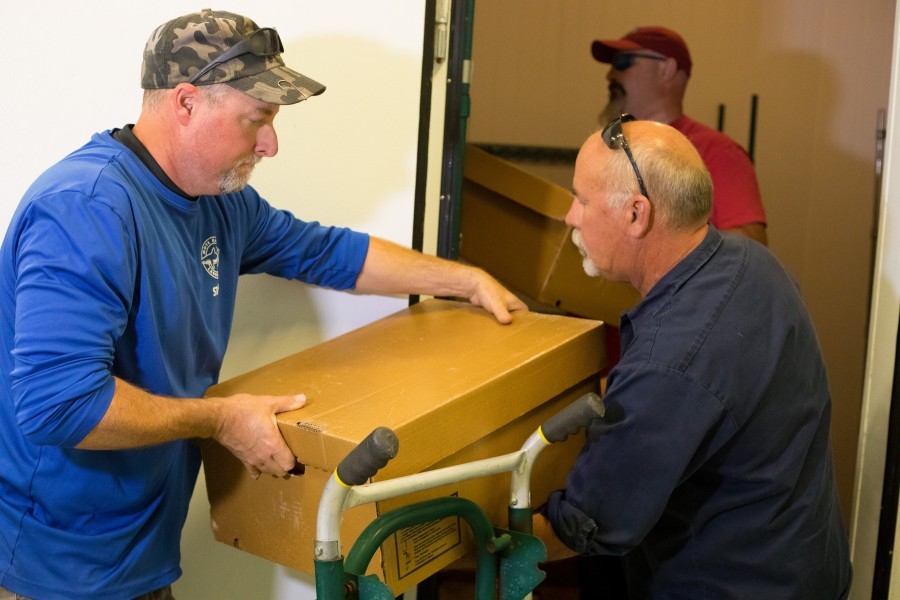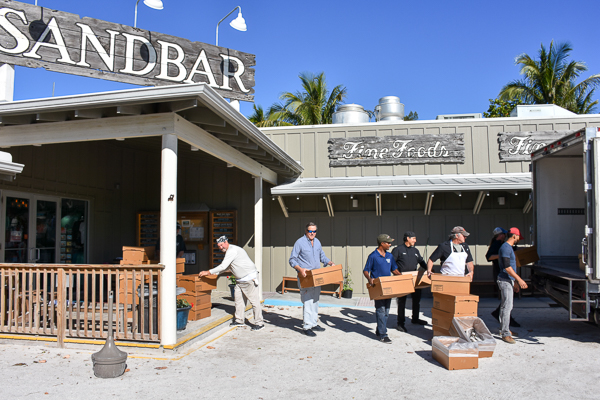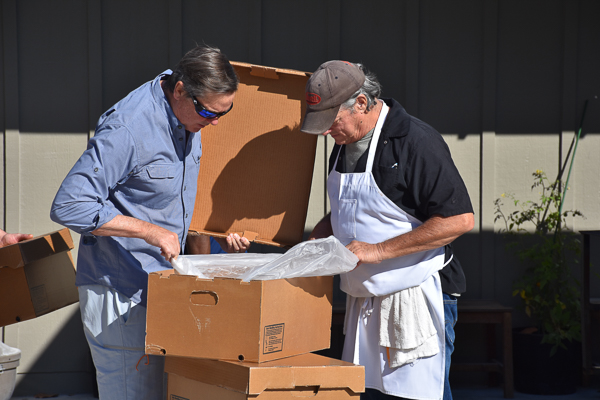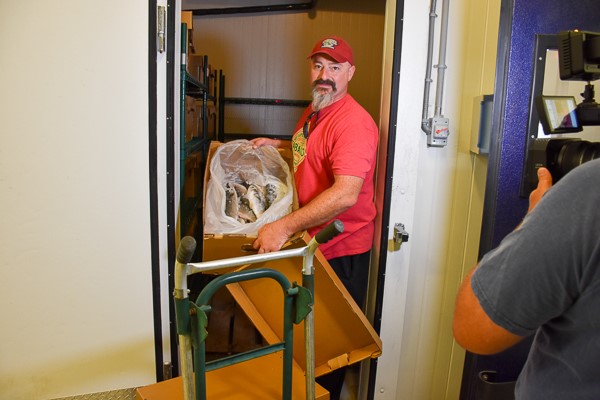Mote study aims to add value to southwest Florida mullet fishery

Mote Senior Biologist Tom Waldrop & Steve Duncan, truck driver for Chiles Restaurant Group, move mullet for Mote study.
Study begins second phase with donation from Chiles Restaurant Group
Credit photo above: Conor Goulding/Mote Marine Laboratory
---
In southwest Florida, cured mullet roe called bottarga fetches higher prices than the fish producing it, and sometimes unused fish are left after bottarga is sold. Now, Mote Marine Laboratory scientists are investigating how to turn excess mullet into food for fish farms, to benefit mullet fishermen along with the fish farming, or aquaculture, industry.
Mote is launching the second phase of this study now, with help from a generous supporter, Ed Chiles, CEO and owner of the Chiles Restaurant Group, which includes Sandbar, Beach House and Mar Vista Restaurants, whose menus and features showcase mullet, bottarga and other local underutilized species.
The Chiles Restaurant Group worked with fishermen based in Cortez, Florida, to procure and donate 600 pounds of frozen mullet to Mote scientists on April 17.

Robert Baugh, Chiles Group COO, helps deliver mullet to Mote Aquaculture Research Park. Credit: Conor Goulding/Mote Marine Laboratory
During the project’s first phase in 2015-2017, Mote scientists and the research arm of Zeigler Brothers, a commercial aquatic feeds company, formulated and tested their first mullet-based feed with freshwater sturgeon raised at Mote Aquaculture Research Park in Sarasota County.
“We showed that we could successfully feed these freshwater fish a diet formulated from excess mullet, to increase the value and sustainability of the region’s mullet fishery,” said Mote Senior Scientist Dr. Kevan Main. “In sturgeon that ate the mullet-based diet, we found increases in beneficial bacteria associated with production of antioxidants, vitamin B12 and antibiotic effects. There was no significant difference in fish growth and survival between mullet- and menhaden-based diets or a standard commercial diet. These findings confirm that our mullet-based feed performed on par with commercial feeds already on the market.”
Main continued: “Now, the key is to find out whether we will see the same results in marine fishes. If we have similar results with saltwater species, we have greater confidence to say that mullet is an excellent source of fish meal.”
A number of aquaculture feeds are produced through targeted fishing for species like menhaden, anchovies or sardines in the wild. By using excess mullet already caught for other purposes, without creating or expanding any fishery, Mote scientists are investigating how to add value to feeds without increasing environmental impacts.
Ed Chiles stated: “We are excited to be able to provide support for the second phase of the mullet feed trials, following the launch made possible through the funds provided by the Gulf Coast Community Foundation’s ‘X Prize’-style competition.”
Chiles continued: “Grey striped mullet built the village of Cortez, one of the oldest continual fishing villages in the state of Florida. While the roe from southwest Florida’s Sandy Bottom Grey Striped Mullet is prized internationally, the remaining byproduct, known as a shuck, is often underutilized.
“If the fish meal project conducted by Dr. Main and her team at Mote is successful, we could see this underutilized sustainable natural resource become another value-added opportunity. That opportunity can be a model for how our area addresses the severe imbalance in our country’s seafood trade deficit, which is second only to oil. Fifty percent of the seafood consumed internationally is from aquaculture. Making better use of our natural sustainable seafood resources in this regard will ensure that our history and heritage of working waterfronts can continue. It will contribute and support our local fishermen and it will make a strong statement about our community’s values.”



Top: Chiles Restaurant Group owner and CEO Ed Chiles and the Sandbar culinary team transport mullet donated to Mote. Bottom left: Chiles (left) works with the culinary team. Bottom right: Sandbar Executive Chef Rich Demarse. Credit all three: Chiles Restaurant Group
The study successfully competed for funding from Gulf Coast Community Foundation — initially as part of a project in their 2015 Gulf Coast Innovation Challenge. With the Chiles Group donation of 600 pounds of frozen mullet, Mote scientists are finalizing plans for their second set of research trials. First, Mote will ship the frozen mullet to a specialist for processing into fish meal, then to Zeigler Brothers research group, who will use the meal to prepare the diet. By late summer or early fall 2018, Mote scientists plan to have the diet ready and conduct the saltwater fish diet trials.
If the diet shows promise for both freshwater and marine fishes, then Mote scientists and partners will seek to prepare it for commercial use, offering the aquaculture industry one more tool to meet the challenge of growing demand.
New, alternative feed sources are greatly needed, according to the 2012 report “The Future of Aquafeeds” by the National Oceanic and Atmospheric Administration and U.S. Department of Agriculture (read it here). The report notes that, “Currently, the production of feeds for aquaculture worldwide is the most rapidly expanding market in the animal feeds production sector increasing 6-8 percent per year.” However, some wild-caught fisheries cannot necessarily continue growing their production to meet that need. “As stocks of pelagic or reduction fisheries used for feed, direct consumption, and bait are limited and already fully utilized, alternate sources of protein and oil are needed for aquaculture feeds,” the report suggests.
Alternatives explored by the report include plant-based, algae-based and newly optimized animal-based feed ingredients, including better use of byproducts or coproducts of existing fisheries processing. “Recovery and utilization of fisheries processing waste should be encouraged and increased.”
“We could consider the excess mullet a coproduct of the fishery in southwest Florida,” Main said.
Demand for aquacultured seafood is expected to continue growing as many wild fisheries struggle to meet the demands of a growing, global population. Mote scientists hope that their current project will, in time, feed into real solutions.